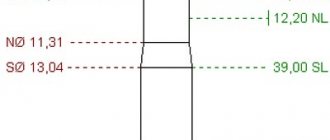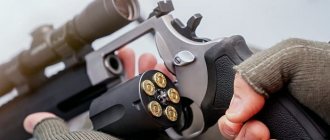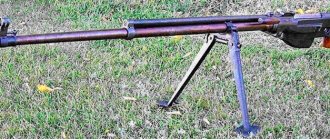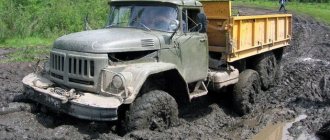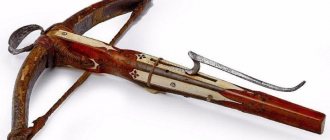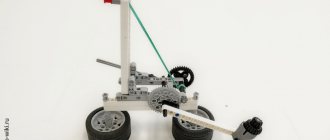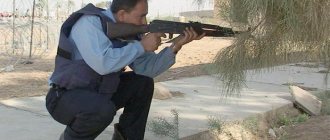The desire of the ancient proto-man to repel predators and obtain high-calorie food in the form of meat once led to the creation of the first weapon. And if at first primitive tools like sticks were used for this purpose, then more and more advanced tools were invented: a spear that can be thrown at a distance of several meters, a sling that can hit at a distance of up to 50 meters, and, finally, a bow from which you can hit a target at a distance of more than 100 meters. The desire for improvement and invention allowed a person not to stop there and come up with an even more effective solution, devoid of the disadvantages of the bow (the inability to keep it cocked for a long time). The product of the ancient engineer's mind was a crossbow, which tripled the distance an arrow travels. It was much more convenient than a bow, and made it possible to keep the weapon in combat readiness while tracking down prey. The crossbow also came in handy for military operations. Light bow arrows could not compare with the armor-piercing power of the iron bolts used by European crossbowmen. The weight of such a projectile reached 400 g, of course, it could not penetrate good armor (unless it was fired exactly at a right angle and at a short distance), but chain mail was no longer an obstacle for it.
This is the glorious history of the crossbow, which has been the main weapon for centuries. But even in our time it has not been forgotten - you can purchase a modern model in any weapons (or sports) store, where at least one of such popular crossbows as “Black Python”, “Tarantula”, “Cheetah”, “Aspid” and other. And if you go to a specialized salon, the abundance of models can make your head spin.
Of course, today a crossbow is no longer that medieval unit. Now manufacturers have modern materials at their disposal: carbon, duralumin, plastic, as well as technological products, in particular, optical or diopter sights, vibration dampers, systems that prevent dry shots, etc. And when looking at some models, for example, you catch yourself thinking that it is unknown which weapon today is more “deadly” - throwing or firearms.
Lethal force
If we talk about the destructive power of a firearm, then everything is simple - a bullet flying at a speed of up to 800 m/s is capable of not only inflicting a wound incompatible with life, but also piercing through any animal. What about the crossbow? It all depends on the tension and the arrows used, but even not the most powerful models, if successfully hit, cause heavy blood loss, leading to quick death. This is precisely the skill of the hunter - to hit such a point on the animal’s body in order to ensure such a wound, because you cannot make a “burst” from a crossbow. Moreover, even if the animal does not fall dead on the spot, it still will not run far with a metal bolt.
Which crossbow is better to buy
One of the main criteria for choosing a crossbow is the speed of the arrow. The value can reach 120 meters per second for the most productive models. To hit a target at a distance of 60-80 meters, a crossbow providing up to 100 m/s is sufficient.
It is important to consider the recoil when using it. It is influenced by factors such as the length of the shoulders and the direction of their movement. The accuracy of the hit directly depends on this. Crossbows with short arms, whose motion vectors are directed in opposite directions, are characterized by the lowest recoil.
Don't forget about size and weight. Compact and lightweight models are more convenient for dynamic or long-term hunting. Long and heavy crossbows are designed to hit targets in open areas.
The specific design also plays a big role in the ease of use of a weapon. There are recursive and block models.
The former require certain operating skills, but are easy to repair and easy to recharge. Compound crossbows are characterized by easy cocking of the bowstring and greater power.
According to current legislation, the right to use a crossbow for hunting can be used by holders of a military ID and a permit to store and carry weapons. In this case, the arc force of the model should not exceed 43 kG.
Recommendations: 10 Best Archery Bows
12 best body armor
14 Best Air Pistols and Rifles
Combat accuracy
In terms of accuracy, modern crossbows are far from their predecessors. Even without an optical sight, using only a diopter, you can easily hit a coin from 20 meters, and from 50 meters you can shoot a dozen arrows into a target the size of a postcard. Of course, the hunter’s experience and the quality of the shooting also matter. By the way, if we compare throwing weapons and firearms, we can note one more advantage of the first: in order to zero a rifle, special conditions are needed, and this is not easy to do in a modern city, but there are no such problems with zeroing a crossbow, it can be done even at home, if the length of the room allows.
Dimensions
Perhaps the main disadvantage of a crossbow in comparison with a firearm is its more substantial dimensions. Of course, there are compact models that are not as wide as most crossbows, but still cannot be compared to a regular shotgun. However, hunters quickly get used to some of the clumsiness of this weapon and calmly cover kilometers through the forests without complaining of any inconvenience.
Crossbows: compound or recurve
The structure of a crossbow: the difference between block and recurve ones.
From the Author: When I started writing this article, I, probably, like many authors on similar topics, thought to start with an excursion into history. I wanted to tell the reader about the reasons for the appearance, development, and design features of ancient crossbows. And then it would be logical to move on to a story about modern models of these weapons, wouldn’t it?
It's good that I came to my senses in time. Nothing like that will happen here. Here you won’t read about the creation of the very first crossbows, you won’t see information about forged bows that have an incredible tension force, and you won’t learn the peculiarities of their descent. You won't learn about rope gates and waist hooks. Let's leave the carved, richly decorated crossbow stocks of the Renaissance to historical reconstruction. After all, what century are we living in?!
Instead, dear reader, I propose to immediately plunge into the vast and interesting world of modern crossbows. Where carbon and plastic, duralumin and alloy steel rule the roost. So, let's begin!
Modern crossbows
Let's look at two main types of crossbows.
Why basic?
Because in addition to the usual design for crossbows with a horizontal arc, there are several other designs that are sometimes strikingly different from the traditional one. It would be a stretch to call some of them crossbows, they look so unusual. Nevertheless, they belong to the crossbow family and actually exist
But we won’t focus on them either.
Modern crossbows, although they have undergone a number of significant changes over the years of development, are still classic examples of this weapon.
They are presented in two types, the main difference of which is the design of the flexible shoulders. These are block and recurve crossbows.
Ammunition
If you compare the cost of cartridges and crossbow arrows, shooting from a firearm would seem to be cheaper. But arrows, unlike bullets, can be reused, and therefore one set can last for the whole season, and even for a couple of years, if used wisely.
Earlier we talked about the crossbow as a hunter's tool, but we should not forget that it is also a military weapon, and this was precisely its main purpose in medieval times. How are things going with these today?
If you think that the times when the crossbow was used by the military are gone forever, then you are mistaken: today its modern models are in service with some special services of different countries. Even elite military units do not hesitate to use such weapons to solve some complex problems, and this is not some kind of secret - everything is official. Of course, they do not use the crossbows that we see in stores, but the most modern models equipped with all the achievements of modern technology. Moreover, there is even information about which brands are preferred by certain departments in Western countries. There is also data on specific examples of the use of such weapons, one of them is Operation Desert Storm. There is no information about whether the Russian special services use crossbows, but I think they are unlikely to lag behind their foreign colleagues.
What makes modern crossbows such effective weapons that even elite units use them? Firstly, they are made from materials that make them reliable. These include stainless steel, duralumin, plastic, as well as Dacron or Kevlar (for the bowstring). New materials are not so dependent on environmental influences - fluctuations in temperature and humidity, and provide strength and “fatigue resistance”. Secondly, crossbows are equipped with elements that make them more effective and convenient. Thus, an optical sight allows you to achieve incredible accuracy over long distances. However, all this is just a way to make ancient weapons modern. What was the reason for your interest in an already seemingly outdated object?
The most obvious advantages of a crossbow: low noise level during use, the ability to be used unnoticed. Due to the fact that the classic crossbow is characterized by a simple trigger device, it is reliable and can be used in any conditions. It has very few moving parts, so the risk of breakage is minimized, as is the likelihood of “jamming” or other problems that may cause the crossbow to not work. There are no misfires or jamming of the arrow on the guide, an accidental shot is eliminated due to the presence of a fuse - even if it falls from a great height, this cannot happen. Moreover, if the weapon is well-aimed, then the shooter simply has no reason not to hit the target. Of course, some external factors, in particular wind, can affect the accuracy of shooting, but otherwise the crossbow guarantees accurate shooting in any weather. And thanks to the ability to reuse arrows, there is no need to take a large number of them with you - one set is enough. At the same time, you can increase your chances of catching by using special arrows. Today, in addition to the triangle tip shape familiar to everyone from drawings and historical films, there are many others that are more effective for hunting: four- and octagonal, with a cutting edge, with blades, there are even blunt-pointed ones for stunning, explosive and luminescent.
What else is the advantage of a crossbow in the eyes of special forces? The arrow has a steep flight path and, accordingly, a limited radius of destruction. Sometimes this becomes a very important advantage of a weapon. For example, for anti-terrorism units that need to eliminate a group of bandits on a crowded street. If you shoot from a sniper rifle, then a miss threatens unnecessary casualties among civilians, because a bullet can kill a person at a distance of several hundred meters. And in the event of an accurate hit, no one rules out that the bullet will not fly right through and injure another person. And there is also the danger of ricochet. All this makes the crossbow a more suitable weapon for such operations. Even if you miss, the arrow will fly a couple of tens of meters and stick into the ground, and if it hits a wall, it will not ricochet, but will most likely break. A modern body armor does not protect you from being hit by an arrow: it simply pushes apart the threads from which it is made. But even if the arrow cannot wound a person, the blow from the hit will knock him down. There are other situations when a crossbow becomes the only suitable weapon, for example, when, when storming a building, you need to throw a rope with a grappling hook to a height of several meters. Some other devices are thrown in a similar way.
To effectively use a crossbow for their purposes, special units need regular training. It is impossible to use this weapon without training. This is not a case where a cavalry charge is enough. And in ancient times, crossbowmen were a special branch of the military - in fact, they became the first highly professional army. To become a real crossbowman, warriors underwent training for many months. Considering the peculiarity of shooting from a crossbow, having learned to do it well, anyone can easily master a firearm, but otherwise you will have to work hard. That is, becoming a sniper is not a problem for a crossbowman, but becoming a crossbowman for a rifle shooter is much more difficult.
If a crossbow was once used in the same way as a firearm today, including salvo shooting at a group target, today this is no longer relevant. But other situations have arisen when throwing weapons come in very handy.
The best sporting crossbows
Such models are used for competitive target shooting. Sports crossbows are distinguished by high accuracy and high tension force. In some cases it can reach 120 kG.
Bowtech Archery Desert Stryker
5
★★★★★
editorial assessment
100%
buyers recommend this product
The main feature of the model is the unique Center Pivot design. The attachment point to the block is located at the center of each shoulder.
Thanks to this, less load is placed on the ends of each of them, which reduces vibration during shooting.
The universal Weaver rail allows you to attach various types of optics to your crossbow. The trigger safety operates whenever there is no arrow on the guide, eliminating the possibility of a dry shot. The forend is adjustable to the owner's hand, and the block synchronization system centers the bowstring.
Advantages:
- high shooting accuracy;
- no vibration;
- noiselessness;
- wear resistance;
- light weight.
Flaws:
- high price.
Desert Stryker is comfortable when used at close and medium ranges. Ease of aiming and lightweight guarantee accurate shooting at targets.
Browning PSE TAC Elite
4.9
★★★★★
editorial assessment
90%
buyers recommend this product
The double arm design and large eccentric blocks guarantee a high initial arrow flight speed - up to 123 m/s.
The projectile holding system is not a standard guide, but a shelf with brushes. Its use significantly reduces friction and ensures minimal impact on the flight path.
The built-in manual tensioner allows you to cock in just 15 seconds and quickly unload the crossbow. The block is equipped with special rubber dampers. They reduce vibration and noise levels during shooting. Mounting strips make it easy to install additional accessories: lights, bipods or sights.
Advantages:
- high speed of arrow flight;
- accuracy;
- no vibration;
- wear resistance;
- durable frame.
Flaws:
- heavy weight.
Browning Elite is convenient for use not only at close range, but also at long range. An excellent solution for shooting at targets at a distance of more than 90 meters.
Megaline Phantom II
4.7
★★★★★
editorial assessment
85%
buyers recommend this product
The material used for the forend and buttstock is wood, and the shoulders are made from fiberglass. Thanks to this, the model weighs only 2.2 kg, which means it will be convenient when pointing and holding for a long time.
The working stroke of the bowstring is 43 cm with a tension force of 40 lbs. The crossbow is equipped with a dry-shot safety device and an 11-centimeter long sighting bar with a dovetail mount. The elongated design allows the use of projectiles of increased length - up to 43 cm.
Advantages:
- compactness;
- light weight;
- wear resistance;
- accuracy.
Flaws:
- difficult cocking.
Megaline Phantom II is designed for targeted shooting at a short distance from the target. The maximum range for this weapon is 25 meters.
Sanlida Next Camo
4.6
★★★★★
editorial assessment
83%
buyers recommend this product
The butt of the model is made of impact-resistant plastic and covered with non-slip material. Light weight and a center of gravity in the middle make it easy to carry and hold while shooting.
The working stroke of the bowstring is 36 centimeters, the maximum flight speed of the bolt is 114 m/s. The trigger force does not exceed 1.8 kG, the automatic safety eliminates the risk of an accidental shot and guarantees the safety of the owner.
Advantages:
- lightweight design;
- fuse;
- convenient sight mount;
- bowstring tensioner.
Flaws:
- difficulty of repair.
The Sanlida Next Camo is designed for shooting with long bolts. It can be used at short to medium range.
READ ALSO
10 Best Survival Kits
Silently eliminating sentries
How is a crossbow useful in a situation where you need to “take down” sentries? It ensures noiselessness and high accuracy, and the effect of its use is such that the object is unlikely to be able to not only run away and warn others, but also shoot back: even if the wound turns out to be non-fatal, moving with a huge arrow in the body will be problematic. It is also important that the sound of a fired arrow is not associated by a person of our time with danger and will not cause an unnecessary reaction. If you miss, the arrow will simply fly past and stick into the ground without disturbing the sentries. In this case, the shooter will have a chance to repeat the shot.
Making shoulders and stock
Let's say you have everything you need on hand. How to make a crossbow with your own hands, at home, step one - carve the shoulders. They are made from a single piece of wood, not separately. The workpiece must not have defects, knots, etc. The inner part of the arc should have a semicircular relief, similar to the letter D, the outer part should be flat.
Figure 6. Crossbow arms are usually hewn from wood
Initially, the shoulders are carved like a slightly curved board, after which they can be processed and bent during assembly. The shape is diamond-shaped, beveled towards the ends of the arc, the bevel angle is small. Take a closer look at the growth rings on the log: it is desirable that the entire structure of the shoulders be on the same layer. To make a powerful crossbow for hunting, use more resilient wood. In general, the safety margin and performance characteristics should be sufficient for medium-sized game (Figure 6).
The shoulders are secured in two ways:
- The first is the winding.
It is performed both by drilling the stock and making a carving in it, followed by winding the rope around a fixed piece of wood. The main point is that the shoulders are not drilled, maintaining their structure. But this is a labor-intensive process that requires time-consuming winding. For reliable fixation, it is recommended to thread the rope through a ring that presses the frame in the middle. - The second is fixation.
For wooden ones, it is implemented in a cunning way: a conical groove is made at the end of the block with an angle of inclination of the walls in the region of 80-85 degrees, as wide as the shoulders. The frame is squeezed into this recess and then pressed with winding. The implementation of the winding is as follows: another groove, rectangular, is made in the lower part of the log. A piece of wood 5-10 cm thick is taken, a rope for winding is fixed on it, after which this anchor should be pulled to the groove and driven in there. The beam should be wound 5 cm before the groove itself in order to be able to fix the shoulders with its tension.
The steel arms are easily fixed using both the listed methods and ordinary bolts (Figure 7). How to make a crossbow arrow at home?
There are three options:
- The simplest one
is to have a circular saw, a drill with a wide nozzle, and a vice. Using a circular saw, unravel the timber into small bars, no more than 2 cm thick. After this, process it with a plane until the initial roundness is achieved. Next, fix the workpiece in the drill nozzle and, starting the rotation process, pass it through the cutter fixed in a vice. An alternative to this obscenity is a wood lathe. - Medium,
relying on luck and straight pieces of wood. You will need a knife for turning round shapes. An alternative is the processing of small beams sawn on a circular saw. - Difficult
- sharpening a straight branch.
Figure 7. The arrows must be perfectly straight.
For the fletching, use a hacksaw to make a thin, even slit in the back of the bolt. Find a wide plastic lid (a plastic paint bucket, a flat sheet of plastic from the store) and cut out blades for the bolt. You can also secure them by making holes instead of sawing the entire part. The dimensions of the trigger for a crossbow are different; you should mainly rely on monolithic types of levers. They can be made either from metal or from hard and thick wire.
Sabotage purposes
This may seem too similar to the plot of an action movie, but the crossbow is also successfully used for sabotage purposes. Using an arrow with a cutting tip, a good shooter can easily cut wires up to 2-3 cm thick, rope or fire cords. Using incendiary arrows you can achieve your goal much faster than using the corresponding small arms ammunition, since they contain more incendiary composition. There are also explosive arrows that can also be used in sabotage operations.
Crossbow
Let us now consider what a medieval crossbow was in Rus', the characteristics of this device, design samples and other interesting facts related to this type of weapon.
The main part of the crossbow - the bow - was made of iron or horn. It was attached to a wooden butt. It also had a stock and a special groove into which forged short bolts, usually made of iron, were placed. This device had a release lever, pressing which activated the entire mechanism, that is, it released the previously engaged bowstring.
Remote target marking
Another task that a crossbow does well is marking certain protected targets. For example, you need to mark some structure so that it can be easily identified by aviation, but this is difficult to do due to the vigilance of enemy forces. How to cope with such a task? For this, there are special crossbow bolts - luminescent or coated with a radiating composition that irrigates the roof of the desired building. And powerful crossbows, which can be fired from tens of meters from the target, make it possible to deliver an arrow unnoticed.
Step-by-step instructions on how to make a crossbow
Between the firearm and the throwing one, between the slingshot and the sniper, there is an inverted bow - an elegant weapon for long-range combat within 250 meters. Penetration ability is within the limits permitted by the Constitution of the Russian Federation (Figure 1).
The law does not consider this type of hunting tool as a bladed weapon or a firearm. The only restriction is as follows: a crossbow made from improvised materials should not have a shoulder tension force of more than 43 kilograms. After overcoming this mark, the master will most likely meet with a squad of law enforcement officers. Consider this point before making a crossbow with your own hands.
In general, this is a relatively accurate, reliable, cheap to manufacture and, due to the specific design, an absolutely quiet weapon. An excellent tool for quiet hunting or defending land rights. Historically, the roots of this invention go back to the 5th century BC. Contrary to popular belief, it did not replace the bow, but complemented existing tactical solutions. It’s easy to learn how to shoot with the device: all you need to do is pick it up at least once. It's like a gun with a trigger - cock and shoot. True, then you should tighten the rope again and put the bolt in the stock, but this is purely practice.
Crossbow-based devices
We have already discussed above how a crossbow can be useful in anti-terrorist operations. However, by taking it as a basis and modifying it a little, you can further expand the scope of use and the tasks solved with its help. And this is not some speculation based on Hollywood films. In our country, such a tool was recently developed - the Moscow company created the “Blesna” remote demining complex based on a crossbow.
The complex, invented for anti-terrorism units, cannot shoot ordinary bolts like a standard crossbow - such is the price of acquiring new abilities. But with the help of this invention it is possible to throw a special “cat”, with the help of which explosive devices are neutralized, at a distance of up to 70 meters. The “cat” used in this case can be dragged through obstacles in the form of thick grass or a wire fence, but at the same time it perfectly captures any trip wires and transports the mine over a long distance. Using a harpoon, you can detonate mines that are programmed to go off when you try to move them.
Another possibility that the creators of the Blesna complex foresaw was the use of a stele - a pyrotechnic destroyer. It is loaded with a blank cartridge from an AK-74 assault rifle and launched at a suspicious object. If there was an explosive inside, it would go off without harming anyone. And if it’s just luggage forgotten by someone, then it scatters with a diameter of 2-3 meters, demonstrating its contents.
Crossbow shooting
The more powerful crossbows became, the more cunning their preparation for shooting was.
In fact, there were even more ways))
The bowstring on crossbows of the early Middle Ages could be cocked with both hands. At the same time, the crossbow was pressed to the ground with a foot threaded through a stirrup at its end.
Then they began to hook the bowstring to a hook attached to the belt, and the crossbow itself, using the same stirrup, was pulled down with the foot.
In order to load the much more powerful crossbows of the late Middle Ages, a force of 300-600 kg was required, which was impossible to do manually. A special tension mechanism appeared that made it possible to hook the string with a hook and tension it using a system of gears.
When the crossbow was cocked and the bolt was in place, the shooter could only select a target and release the bowstring.
On modern models of medieval crossbows, with a much weaker bowstring tension, it looks like this:
https://youtu.be/zWlFASPc1-A
Here I would like to add that when shooting from a crossbow, it was not rested on the shoulder, but only pressed against the cheek, for better aiming.
They will begin to resist later, when the familiar rifle stock appears, and shooting from a crossbow becomes an idle pastime of bourgeois society.
Hunting
Basically, hunting with a crossbow is carried out by wealthy people - equipment for it is not cheap, and it is not allowed everywhere, which means you need to travel abroad. However, for some Russian residents, the ban on the use of throwing weapons when hunting is not a hindrance, judging by the sales volume of crossbows. Interest in it is also limited by the fact that you need to have considerable courage to go after a large animal not with the usual rifle or shotgun, but with a crossbow. However, in the USA and Canada the situation looks different: here at least half of hunters use throwing weapons.
Selection and preparation of material
Before moving on to the instructions on how to make a crossbow from wood, prepare your materials in advance. Look around the area and try to remember which of the required tree species grow in the area (Figure 4).
Let us repeat that at home, a wood crossbow can be made from the following species: birch bark, acacia, oak, ash, yew, hazel, bean or acacia. Most often, the listed species are found in local forests and forest plantations. If there is a nearby coniferous forest, we recommend looking for spruce and pine forests. Particular attention should be paid to maple groves. Having found the central maple daddy, look for straightened young trees and select one with a thickness of 5 to 15 cm. The search radius around the main tree is from 40 to 50 meters.
Learn the ax factor, or better yet, the chainsaw factor. Try not to harass the forest area too much. Having cut yourself a log, do not rush to carve a crossbow out of it. First, it will need to be dried and then processed. Drying time in a warm, dry room is from two weeks to two months. Cover all cracks, pores and other irregularities with oil paint and place it on the mezzanine.
Figure 4. Weapons can be made from wood and metal
If it is impossible to obtain wood directly from the forest, order a block of the species you are interested in via the Internet. A variable advantage will be saving time on wood processing; operators can often clarify the dryness of the beams and the method of processing them. But this negates all the romance of traveling and finding the right snag.
Working on the shoulders will take the same amount of time as creating the stock. Both processes require basic woodworking tools - a plane, knife, ax, files. The bed can be decorated with carved patterns or adjusted to fit your own hand, whatever you like. There are no restrictions on the use of materials; both components can be made from the same rock. It is recommended to coat the timber with special solutions to avoid corrosion and rotting, as well as with wood varnish. The shoulder blank should also be treated with protective solutions, but not varnished.
The next point is what to make a crossbow bowstring from:
- You can make a bowstring from scratch from Dacron or Kevlar fibers, but to do this you will need to knit the rope yourself (Figure 5).
- Of the ready-made models, attention should be paid to durable varieties of ropes: cord, polypropylene, nylon, hemp, hair. Of these, only the last two are vulnerable to moisture.
- The golden rule is to focus on stretchability: it should be minimal.
- The edges of the rope attached to the shoulders should be treated in a special way, but not tied. To do this, the cord is wrapped around the workpiece to obtain a shape, then the end is applied to the base and tightly wrapped with a thread of smaller diameter.
- The recommended indentation is 5 cm. Along the way, each layer of the winding is covered with heavy-duty glue (anaerobic, epoxy resin, hot melt glue), and at the end the entire structure is tightly wrapped with a piece of felt. Any knots fray the rope, worsening its quality and increasing the chance of breaking under load.
The final stage before shooting is to make arrows for the crossbow, or as they are also called, bolts. Making consumables requires blanks from solid wood or straight branches. If you have woodworking equipment, cut out several bolts from the beams. They can also be printed on a 3D printer, but such shells will not last long. Get two sets of bolts - with and without soft ends.
Figure 5. The string should be strong, but elastic enough
The former are perfect for re-enactment and role-playing battles; the pointed tip should only be used for hunting. A hunting point is made of wire, tin or aluminum. Keep it light! For the plumage you will need separate blanks made of wood and plastic.
Types of crossbows
The hand-held crossbow had a special iron bracket for the convenience of resting the foot when loading. A primitive trigger device ensured the release of the bowstring when shooting.
The other was an easel crossbow. This design turned out to be more powerful and massive. If a hand-held medieval crossbow measured approximately one meter in size (the exact parameters are shown in the figure below), then in this case they turned out to be much more impressive. Here the main part of the structure was installed on a special frame on wheels, otherwise called a machine. The bow was made of steel; a thick, strong bowstring was made of ox sinew or rope. For cocking, special geared devices called self-firing rotators were used. The tensile force of such a structure was estimated at twenty human forces.
